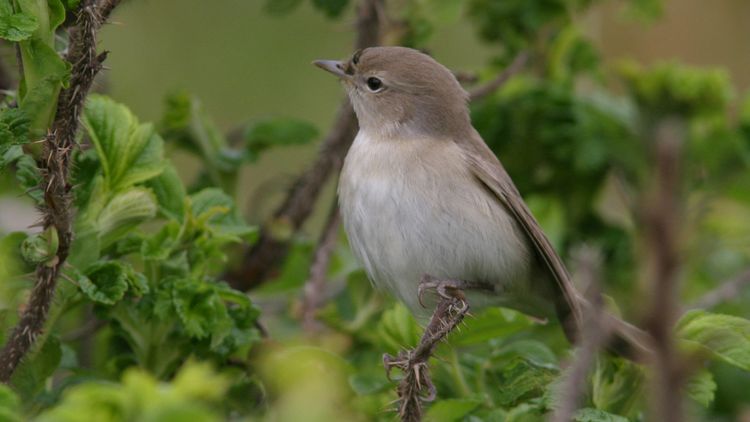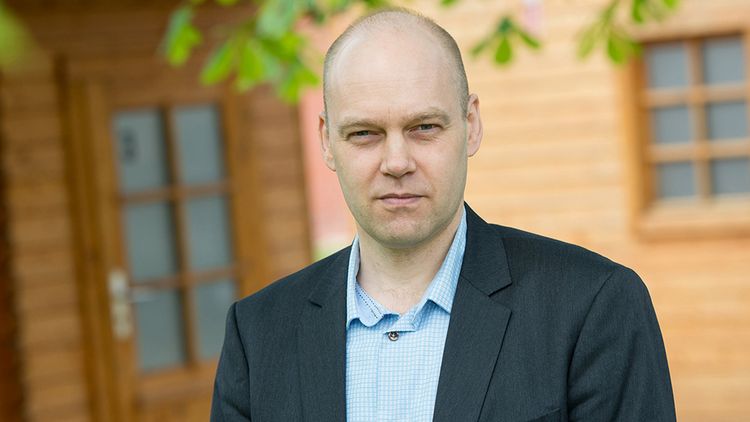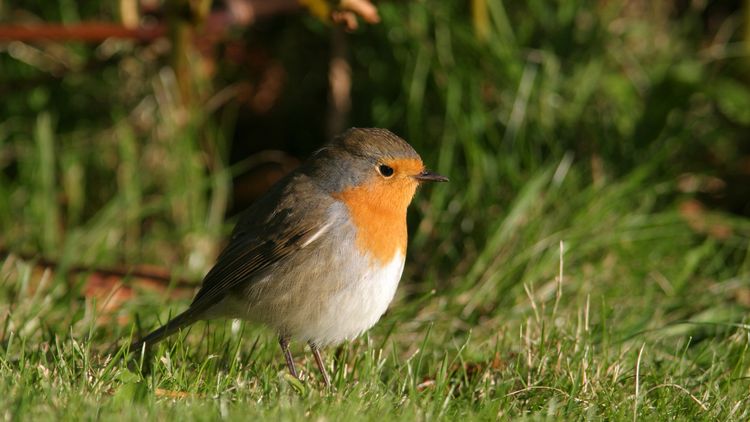For more than 15 years, Prof. Dr. Henrik Mouritsen has been conducting research on magnetoreception in birds. Now, he has summarised the current scientific knowledge in the journal Nature. Here, the neurobiologist talks about his fascination with birds and why fundamental research is so important.
QUESTION: You have banded more than 6000 birds throughout your life. What was the most memorable experience as a bird researcher?
ANSWER: As a student, I went to the Philippines where we cut our way through the rain forest with a machete. We caught a little flycatcher, which had a bright orange tail with an inverted black T in it – and it had not been described in a bird book before! We felt like explorers. That was a fantastic experience for a young guy interested in birds.
QUESTION: What got you interested in birds in the first place?
ANSWER: I had a teacher in primary school who was very interested in birds. He was extremely inspiring and sparked my interest. And I have retained this interest. As a student I was a so-called twitcher: Any time, a rare bird was seen somewhere in Denmark, I was called and we went – no matter what we had to do otherwise. Back then, I started to wonder: Why does a bird from Mongolia suddenly occur in Denmark? What went wrong? Because these were mostly young birds, there must be something genetically or mechanistically wrong. I started to read the literature about what was known about navigation. But I was not very impressed, to be honest.
QUESTION: Back then, what was known about how birds find their way over distances of thousands of kilometres?
ANSWER: It was clear that birds could use the magnetic field, the sun and the stars for navigating. There were lots of different opinions about what is most important. And of course, researchers knew that birds need a mechanism to sense the magnetic field. But most studies were on bird behaviour. Almost nothing was known about the molecular biology and the brain function related to the magnetic sense. So, during my PhD, which was purely behavioural and mathematical, I realised: To really understand the behaviour of the animals, you have to start looking at the details. This is why I went to Canada in 1999 to learn about neurophysiology.
Early milestones
QUESTION: You’ve been conducting research at Oldenburg University since 2002. What are the major milestones of your work?
ANSWER: In 2000, it had been suggested theoretically that a certain class of molecules, cryptochromes, could allow migratory birds to perceive the magnetic field as visual patterns. So, we started to look in more detail at this molecule and at the brain. In 2004, my colleague, the neurobiologist Reto Weiler, me, and our teams actually found cryptochrome in the retina of migratory birds. In 2005, my colleague Eric Jarvis from Duke University, me, and our teams discovered a region of the brain called Cluster-N. We could show that it is light-dependent and processes, most likely, magnetic compass information. Later on, in 2009, we showed: If you lesion the Cluster-N region, the magnetic compass doesn't work, but the sun and the star compass still work. We know this from behavioural experiments. These were suggestions, to begin with. Nowadays, I’m 99 percent sure that Cluster-N is a magnetic compass centre in the birds’ brain. However, the cryptochrome we looked at back then is probably not the right one. We recently found that a different cryptochrome is more likely to be involved. But we were close, at least. These were the major early milestones.
Extremely sensitive
QUESTION: Over the past ten years, your group has worked closely with your British colleague Peter Hore. What are you currently working on?
ANSWER: We’ve started looking into the exact biophysical mechanism behind the magnetic sense. You cannot describe what is going on in a bird’s eye with classical mechanics. You have to use quantum mechanics because nuclear spin effects in the cryptochrome molecule interact with electron spins and the earth’s magnetic field. All of this generates a chemical compass. I’m not a quantum chemist. That’s why I’m collaborating with Peter Hore and his colleagues from Oxford University. Peter came up with an analogy to explain the processes in a bird’s eye: The cryptochrome molecule is like a granite block standing on its flat side. That means it’s in equilibrium. A little fly would never be able to tip it over. However, we have a lever, which is the light. The light comes in and puts the stone on its edge. This is the state of the molecule we call the radical pair state. It’s very far from equilibrium and only exists for about a microsecond. But in this state, it’s extremely sensitive to perturbation. Now, it matters, not only if, but also where the little fly lands.
QUESTION: And in this analogy, the little fly would be the earth’s magnetic field...
ANSWER: Yes. Depending on the direction of the molecule relative to the magnetic field, the bird will see more or less light. That is, birds can see the magnetic field. The cool thing is – it’s sensitive to interactions between the weak Earth field and the spins. These interactions are about one million times weaker in energy than what was previously thought to be the biological limit. This could be of fundamental importance to biology: What if other biological sensory systems involve intermediates with radical pairs so that you need to understand spin chemistry? There could be other sensory systems as well where much weaker stimuli could be detectable.
Novel solutions
QUESTION: Initially, you started off trying to understand how birds find their way using the earth's weak magnetic field. But now you have stumbled upon something new that may exist elsewhere…
ANSWER: Yes. And this could fundamentally change our view of biological sensory systems. I would never have thought that when I started. Once we had found biological evidence for this mechanism, a lot of people got interested. This is because quantum computers need to solve similar problems. But the problem with quantum computers is: You can't keep the state of the electrons stable for very long and certainly not at room temperature. But it looks like the bird has solved part of this problem within its magnetic compass. So, suddenly governments and companies got very interested in bird navigation. This is one of those examples: If you do truly fundamental research and try to understand systems which are not understood at all, you may come up with completely novel solutions. That's the good thing with the German science system – it still supports fundamental research very well.
QUESTION: In 2014, your group published another landmark finding in Nature, namely that the birds’ magnetic compass is disturbed by anthropogenic electromagnetic noise originating from electronic equipment. Do you now understand how that works?
ANSWER: My group and our collaborators in Oxford have been working on that. It is clear that time-dependent magnetic fields interfere with the interactions between the electron spins and the Earth’s magnetic field. What we are still not able to fully understand is why the birds’ magnetic compass are sensitive the very weak anthropogenic electromagnetic noise.
Fabulous workshops
QUESTION: It seems you are happy with conducting research in Germany. Why did you come to Oldenburg in the first place?
ANSWER: There were two very specific reasons for choosing Oldenburg: When I started, we didn't know what was going on in the eye and the brain. It was clear: If I want to understand the visual system I have to collaborate with somebody who understands vision better than me. That was Reto Weiler and his group. And I wanted to work with Franz Bairlein in Wilhelmshaven (Institut für Vogelforschung) who knows a lot about birds and keeping birds. Since then, the University of Oldenburg has always supported my research. Moreover, we have fabulous electronic and mechanical workshops here: I often need to have stuff built. I may be able to buy something off the shelf. But I need to replace all the magnetic parts, because I cannot record magnetic responses from the brain and have big pieces of iron nearby. So, I need to modify my equipment. The workshops here are really good in doing this. There are few universities who have so many and so good workshops.
Multidisciplinary collaboration
QUESTION: In your recent review, you have pinned down many open research questions. What are your major goals for the future?
ANSWER: If you want to understand bird navigation you need to understand the biophysics and the quantum mechanics of the magnetic sense. Where exactly are the sensors? What is their structure and which are the interaction partners? We need to understand the physiology, the electrical signals, and the pathways. And we want to know how the brain integrates all of this with other navigation-relevant information. We don't know where that happens. We want to figure that out. We also want to find out: How do birds code space in the brain? Are there place and compass neurons? We want to look at these questions on a molecular, neuroanatomical, biophysical but also on a behavioural level – both in the lab and in the wild. This is why we are applying for a DFG-funded SFB in Oldenburg integrating people from quantum mechanics to ecology.
QUESTION: Who will be your future partners in this project?
ANSWER: About two thirds of the principal investigators are from Oldenburg. We are collaborating with Franz Bairlein from the Institut für Vogelforschung in Wilhelmshaven, Onur Güntürkün of the University of Bochum, Miriam Liedvogel from the MPI in Plön, Elmar Behrmann from the University of Köln, Nachum Ulanovsky Weizmann Institute in Israel and Peter Hore from Oxford. These experts cover areas we cannot cover in Oldenburg. In the proposed SFB, we expect to be able to answer about 50 percent of the 20 key questions I have asked at the end of my Nature review.
Interview: Constanze Böttcher





